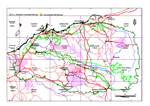Botanical name
Acacia ampliceps x sclerosperma subsp. sclerosperma
Description
Bushy, spreading, glabrous shrubs or trees 2-5 m tall. Bark grey, smooth except longitudinally fissured at base of oldest stems. Phyllodes commonly linear but varying to narrowly oblanceolate or narrowly oblong-elliptic, narrowed at base, (8-) 9-14 (-16) cm long, (2-) 3-10 (-15) mm wide, not rigid, spreading to erect, straight to shallowly incurved or shallowly recurved, green; midrib rather prominent (at least when dry); the apex obtuse-mucronulate. Gland situated on upper margin of phyllode 0-6 (-15) mm above the pulvinus, a smaller gland situated at or near base of apical mucro. Inflorescences axillary racemes (3-20 mm long) which often grow out at apex (with the subsequent inflorescences simple); peduncles 8-20 mm long; heads globular, lemon yellow, sub- densely 15-25-flowered. Flowers 5-merous; calyx ±truncate; petals nerveless. Pods sub-moniliform, rounded over seeds, about 8-13 cm long (length difficult to accurately determine because pods readily break at the moderate to deep constrictions between the seeds into 1 or few-seeded segments), 8-12 mm wide, woody, yellow-brown. Seeds longitudinal in the pods, obloid to ellipsoid, 7-9 mm long, 4.5-7 mm wide, rather turgid but laterally compressed (3-4 mm thick), moderately shiny, dark brown to blackish; aril orange-brown when dry (?red when fresh), normally rather small and straight but occasionally folded beneath the seed.
Characteristic features
Bushy, spreading, glabrous shrubs or small trees. Phyllodes relatively long and narrow (mostly 9-14 cm x 3-10 mm), ±straight, midrib rather prominent. Gland near pulvinus and also a smaller one near apical mucro of phyllode. Inflorescences short axillary racemes (3-20 mm long) which often grow out at their apex (subsequent inflorescences simple); heads lemon yellow, peduncles long (8-20 mm). Pods sub-moniliform, broad (8-12 mm wide), readily breaking at constrictions between the seeds, woody. Seeds large, aril small (?red when fresh).
Distribution and ecology
Known only from the Pilbara region of northwest Western Australia where it is not common and of scattered occurrence (recorded from around Karratha, Millstream, Panawonica, Paraburdoo and on Hillside and De Grey Stations). Grows on floodplains, clay pans or along watercourses. Around Karratha it occurs in the coastal dunes along seasonally dry creeks.
Flowering and fruiting period
Flowers from July to August (possibly also June, but there are no specimen records to verify this). Pods with mature seeds have been collected between October and December.
Variation
Phyllode width very variable.
Affinities
Plants of this putative hybrid have been observed to occur at low frequencies in populations the two putative parents in a number of localities. The hybrids can be recognized by their lemon yellow heads (white in A. ampliceps and golden in A. sclerosperma subsp. sclerosperma) and their phyllodes (and to some extent their pods) which are intermediate in width between the putative parents. Acacia ampliceps also hybridizes with A. bivenosa (see A. ampliceps x bivenosa for discussion).
Conservation status
There is insufficient information at present concerning this entity to justify including it on the Department of Environment and Conservation's Declared Rare and Priority Flora List.




